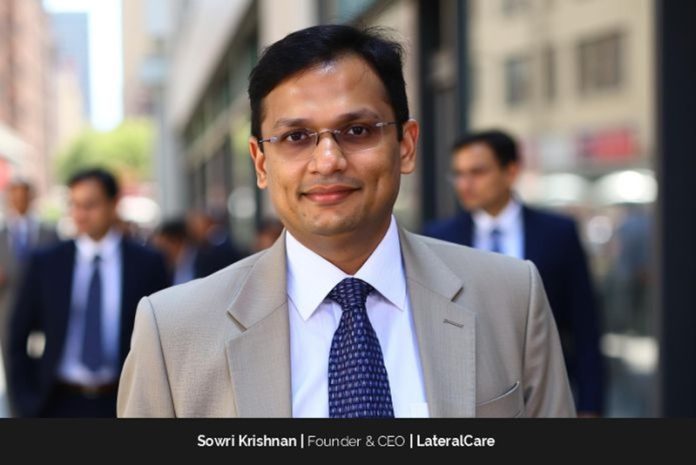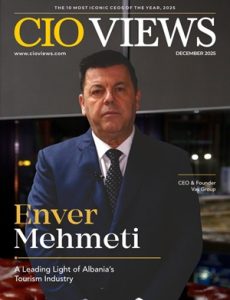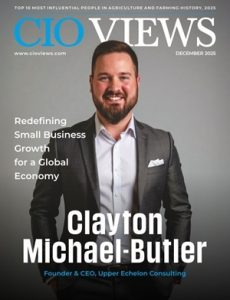Revenue alai, launched by LateralCare in early 2025, is purpose-built to revolutionize traditional revenue cycle management (RCM). As a true disruptor, it delivers automation, accuracy, transparency, and financial outcomes at an unprecedented scale. Its intelligent, closed-loop AI system grounded in the Maker-Checker paradigm is already redefining what is possible in the RCM space.
LateralCare was founded in 2023 by Sowri Krishnan, a trailblazer in healthcare technology and AI-driven innovation. His goal was to fuse human expertise with AI-driven precision to create synergy that sparks true innovation and reshape healthcare operations. As a founder, Sowri is determined to establish new standards for efficiency, accuracy, and financial performance in healthcare technology. Under his innovation-driven leadership, LateralCare is dedicated to provide the most advanced and innovative solutions for healthcare organizations.
The Flagship Platform: Revenue alai
LateralCare’s flagship platform, revenue alai, is a prime example of how advanced AI technology when integrated with deep healthcare expertise can transform traditional RCM processes. Its Maker-Checker paradigm model combines AI-powered execution (Maker) with intelligent oversight (Checker), which delivers unmatched precision, transparency, and accountability.
At the heart of revenue alai is an agentic AI architecture where AI agents serve as “Makers,” automating repetitive, high-volume tasks with a “Human-in-the-loop” decision maker. These agents do not just follow static rules. Sowri explains that the contextual engineered platform leverages domain-trained large language models (LLMs), retrieval-augmented generation (RAG), and contextual data to understand and act on complex healthcare information with human-like reasoning. And in parallel, alai introduces “Checkers.” These are AI analysts that can review, guide, and refine the output of the AI agents, ensuring compliance, auditability, and learning.
Sowri explains that the Maker-Checker framework creates a “continuously improving feedback loop” that mirrors best practices in enterprise governance. While the Maker acts, the Checker validates, and together they deliver “high-confidence automation that is safe, adaptive, and explainable.”
Additionally, unlike legacy RCM tools that function in silos, revenue alai operates as a closed-loop platform. So, insights from every claim, every denial, and every reimbursement event feed back into the system. This allows revenue alai to proactively identify patterns, prevent errors, and evolve with payer policy changes, which eliminates the need for constant manual reconfiguration. “The result is a modern RCM stack that empowers healthcare providers with dramatically reduced denial rates, improved first-pass yield, real-time visibility into financial leakage, and actionable insights at every level of the organization,” according to Sowri.
“By uniting automation with oversight, revenue alai doesn’t just accelerate the revenue cycle — it redefines it,” he adds. The Maker-Checker approach ensures providers can trust the system to execute autonomously, in addition to maintaining the control, transparency, and governance that the healthcare industry demands.
The Platform’s Growth
Since its launch, revenue alai has grown from a focused RCM automation engine into a fully modular, agentic system. It now supports end-to-end revenue operations across diverse provider environments. According to Sowri, the “Checker” layer is where there have been major advancements. Initially designed to validate downstream outputs, the Checker has evolved into a proactive, upstream intelligence layer. It can now detect errors at the source, before they become denials.
“By pushing this validation earlier into the claim lifecycle, we are significantly improving first-time pass rates and reducing the administrative overhead of rework,” Sowri says. This enhances operational efficiency as well as directly accelerates cash flow and improves provider confidence in the system.
Additionally, Sowri and his team are taking real-time customer feedback and market needs into consideration and continuously expanding the platform’s capabilities. He informs that the upcoming features include:
- Predictive analytics that anticipate denial risk before claim submission
- Self-service configuration tools that give RCM leaders more control without engineering support
- Expanded interoperability to integrate seamlessly with clearinghouses, EMRs, and financial systems
Sowri underscores that every feature they add is designed with the same principle: “responsible AI that adapts, scales, and empowers.” They are building toward a future where providers don’t just react to revenue cycle issues, but prevent them altogether
“That’s the promise of revenue alai, and we’re just getting started,” Sowri says.
Founding of LateralCare
Prior to founding LateralCare, Sowri had a long association with building software for revenue cycle operations. This gave him an up-close look at the drawbacks of existing systems. He identified continued inefficiencies and rigid silos as the major issues. Throughout his career, while leading technology transformations in healthcare and financial services, he had seen how legacy systems constrained innovation. According to Sowri, although stakes were high, providers were burdened with outdated platforms, inflated costs, and a lack of real-time insights. “LateralCare was built on the belief that AI could be a transformative force in healthcare if applied responsibly and intelligently,” points out Sowri.
He has a background in cloud-native engineering and AI automation. His expertise in these two areas guided the company toward a modular, agentic approach, where machines handle the repetitive tasks and humans focus on higher-order decision-making. “That fusion of human ingenuity and AI scale became our foundation,” Sowri says.
They follow a “shift-left” mindset, which means pushing innovation upstream, where problems originate. Engineers, analysts, and domain experts are empowered to co-create from the start, not in silos. LateralCare’s teams are small, cross-functional, and outcome-driven. And Sowri highlights that adaptability is baked into their core architecture.
As LateralCare’s revenue alai is designed to be cloud-native, API-first, and composable, it easily integrates with EHRs, clearinghouses, and payer systems. “But more importantly, we continuously retrain our models with real-world feedback — denials, payer rules, appeal outcomes — so our agents get smarter over time,” Sowri says.
And their robust governance framework enables customers to configure business logic without writing code. That ensures compliance while enabling rapid adaptation.
“Our product roadmap is shaped by direct collaboration with providers,” Sowri says. “We listen intently to their challenges, then respond with speed.”
One Major Obstacle: Resistance to Change
Sowri was building his company from scratch. To establish it and fuel its growth, the support of vendors was very much needed. It proved to be a major challenge. There was a “deep entrenchment of existing RCM teams and vendors” within healthcare organizations, he says. Almost every provider they approached already had either an internal revenue cycle team or a long-standing relationship with an external vendor.
“In such a high-stakes, compliance-driven environment, change is naturally met with resistance, especially when it involves core financial workflows,” Sowri says. Breaking through that barrier required more than demonstration of capabilities. It was important to earn trust first in the landscape dominated by incumbents and legacy processes.
Sowri and his team adopted a strategic and collaborative approach, instead of trying to displace the existing vendors overnight. For example, with revenue alai’s Maker-Checker architecture and modular, multi-agent platform, they had the flexibility to introduce just the Checker component, the oversight layer powered by AI analysts. Sowri explains that by doing this, they were able to coexist with the incumbent solution and act as a secondary validation layer.
“Our Checkers audited claim activity, monitored patterns, and flagged inconsistencies in real time,” he adds. “This not only helped enhance compliance and reduce leakage but also gave the provider greater confidence in their primary vendor’s performance — or lack thereof.” In several cases, they also uncovered systemic issues that had gone unnoticed for years.
The secondary approach created a low-friction entry point for LateralCare. Also, it could prove its value without going for a full system overhaul. Sowri says that as trust grew and outcomes improved, providers invited them to take on more of the RCM process. The company eventually evolved from validator to operator.
“This experience reinforced an important principle for us,” Sowri says. “In healthcare, evolution often wins over disruption.” LateralCare aligned with existing workflows and introduced intelligence incrementally, which unlocked transformation from within.
What Makes LateralCare Stand Out
Most AI health-tech startups either bolt AI onto existing workflows or sell black-box automation. LateralCare does neither. Its revenue alai is an intelligent, closed-loop system powered by AI agents for automation and AI analysts for oversight. Other factors that make LateralCare stand out in the highly competitive market are:
- Agentic architecture: Revenue alai separates execution (agents) from oversight (analysts). This ensures accountability, explainability, and real-time human-AI collaboration.
- End-to-end automation: Revenue alai doesn’t just assist. It also autonomously handles the journey.
- Healthcare-first design: Revenue alai understands healthcare revenue ops better than others. Its models are tuned for HL7, CPTs, and payer logic, not just generic NLP.
“We’re not a tool,” Sowri says. “Our platform is a transformation partner.”
Strategic Goals for LateralCare
Under Sowri’s visionary and innovative leadership, LateralCare’s focus over the next 12 to 18 months is on:
- Expanding provider adoption across mid-size health systems and ambulatory networks
- Deepening payer integrations to close the loop on prior auth, coverage validation, and payment resolution
- Launching a self-service AI configurator to help customers tailor workflows without engineering effort
- Achieving HIPAA certification and interoperability benchmarks to remain regulatory-ready
Sowri underscores that these goals align with the broader industry push toward automation, cost containment, and value-based care.
Influencing the Future of Healthcare Technology
Sowri envisions LateralCare as a “proof point” that AI can be applied responsibly, ethically, and powerfully to solve systemic healthcare challenges. He dispels the fear that technology is bound to replace humans. “Our work shows that automation doesn’t have to displace humans,” he points out. “It can elevate them.”
As a seasoned technologist, Sowri hopes to inspire a generation of innovators to think beyond apps and widgets. He notes that systematic solutions are needed to address the biggest problems in healthcare.
“If our journey sparks more entrepreneurs to tackle real inefficiencies with courage and clarity, that’s a legacy I’d be proud of,” Sowri says.
Core Principles of Leadership
“Outcome over outputs” is Sowri’s guiding principle as a founder. He believes that technology is not an end in itself; it has an impact.
Every decision he makes is filtered through one key question: “Does this materially improve accuracy, efficiency, or care delivery for our customers?” According to him, if they do not receive a clear answer, they pause and reassess. Sowri firmly believes that in a space as vital and complex as healthcare, moving fast is only valuable if they are also moving in the right direction.
And as a technologist, he believes in clarity through architecture. Great systems as well as great teams are the result of intentional design, according to him. “I prioritize solutions that are modular, scalable, and resilient, because complexity is inevitable, but chaos is optional,” he points out. “This clarity allows us to build not just for the current use case, but for what’s coming next.”
“Radical ownership” is another core leadership principle of his. At LateralCare, he has empowered team members to own problems and not just focus on delivering tasks. They are also encouraged to take initiative, not just follow instructions. Sowri explains that when people feel true ownership, they move faster, collaborate deeper, and care more about the outcome. “That sense of shared accountability is what drives trust and alignment across the organization,” he says.
As the founder of an AI-first company, the most important principle that Sowri holds is the belief in the “power of human ingenuity paired with the scale of artificial intelligence.” He says that AI can process information at superhuman speeds, but it lacks intuition, empathy, and contextual judgment.
“Human creativity, insight, and domain expertise remain irreplaceable,” he adds. “Our role as leaders is to create environments where these two forces — AI and human brilliance — work in harmony, not in conflict.” At LateralCare, they have operationalized this belief through their Maker-Checker architecture.
AI agents (Makers) automate the heavy lift, while human-guided AI analysts (Checkers) provide strategic oversight. It is a system that honors both precision and wisdom. Sowri carries this same principle into every leadership decision of his: “Using machines to scale, but relying on humans to steer.”
Ultimately, according to him, leadership in this new era is about building systems — both technical and cultural — that can scale with integrity, evolve with purpose, and deliver impact with humanity. “That is what we are doing at LateralCare every day,” Sowri says.
Advice for Emerging Entrepreneurs
Today, many young entrepreneurs aspire to disrupt the healthcare space by tapping into AI. For them, Sowri has three pieces of advice. First, do not build tech for its own sake. “Build around deep, painful user problems,” he says. His second piece of advice is, “get close to the ground.” He encourages young entrepreneurs to talk to real people, especially those who are doing the real work.
Sowri’s third piece of advice for them is: be patient and relentless. “Healthcare has inertia,” he points out. “So, trust is earned over time.”
“And finally, ship fast, learn faster, and stay humble,” he adds.
What Does Success Mean?
On a personal level, Sowri defines success from the perspective of team members. He calls it a success when he a team member steps up, leads fearlessly, and makes decisions he would have made — if not better. That is when he knows the culture he has created at work is working.
And, for LateralCare, Sowri defines success in terms of real-world impact. These include fewer claim denials, faster reimbursements, and healthier balance sheets for hospitals. “If we can move the financial needle while reducing burnout and boosting patient care,” he says, “we have done something that matters.”






